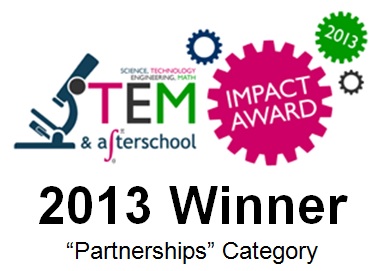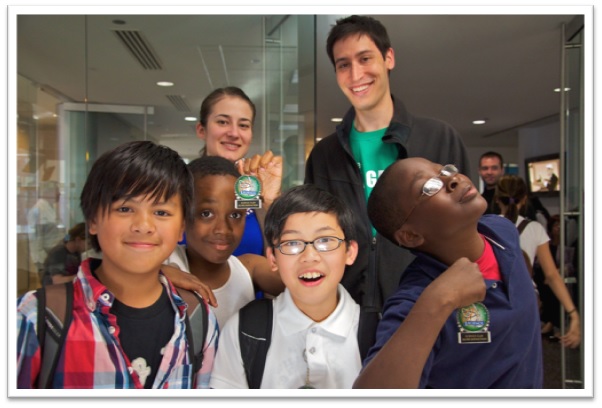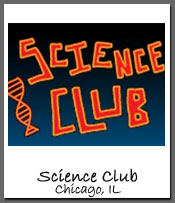 Science in Society, a Northwestern University office for science outreach and public engagement, works to make science accessible to all. Through partnerships with Chicago-area schools and community groups, Science in Society helps Northwestern researchers share their expertise and creativity in a community-centered way. Their focus is to develop sustainable educational initiatives that deliver proven results for groups that need them most. Science in Society, a Northwestern University office for science outreach and public engagement, works to make science accessible to all. Through partnerships with Chicago-area schools and community groups, Science in Society helps Northwestern researchers share their expertise and creativity in a community-centered way. Their focus is to develop sustainable educational initiatives that deliver proven results for groups that need them most.
Since 2008, Science in Society has partnered with the Pedersen-McCormick Boys & Girls Club and Chicago Public School teachers to support Science Club, an after school program focused on youth mentorship, hands-on inquiry, promoting scientific thinking and fostering science engagement. POPULATION SERVED Science Club serves middle school students (grades 5-8) from the Uptown neighborhood of Chicago. Based at the Pedersen-McCormick Boys & Girls Club, approximately 60 urban youth participate in Science Club each quarter and work alongside 30 scientist mentors from Northwestern University. PROGRAM FEATURES Science Club uses a near-peer mentorship model to teach scientific thinking and encourage science engagement. Youth participants work in small groups with Northwestern University scientist mentors each week throughout the academic year (fall, winter and spring). Youth-mentor pairings are maintained from quarter-to-quarter and year-to-year, allowing time for respect, trust and friendships to form. For 90 minutes every week, these small groups tackle challenging, inquiry-based experiments in the Science Club. Mentors guide the kids through the activities but encourage them to find their own solutions. Experimental data is then shared on the Science Club website through youth-authored journal posts. CURRICULUM Science Club has developed six curricular modules specific for an informal setting. Each 8-10 week curriculum centers on a Grand Challenge theme, in which small groups work toward the completion of a large project and finale event. Largely focused on biology and human health, examples of Science Club curriculum include NeuroSports, where youth learn about the neurological basis of athletic performance and test strategies to help struggling athletes, and Medical Mystery, where groups diagnose a young girl’s illness using common medical techniques.  Each curriculum is highly flexible and can be adapted for youth ability level. Science Club mentors tailor the activities specifically to the kids in their group, allowing each to find a unique approach to science education. Groups complete a final project, which they share with other kids through a fun finale event, such as a science fair or competition. The Science Club curriculum is enhanced by field trips to local area labs, science education centers, or talks by guest speakers. Each curriculum is highly flexible and can be adapted for youth ability level. Science Club mentors tailor the activities specifically to the kids in their group, allowing each to find a unique approach to science education. Groups complete a final project, which they share with other kids through a fun finale event, such as a science fair or competition. The Science Club curriculum is enhanced by field trips to local area labs, science education centers, or talks by guest speakers.
In addition to the six Science Club curricula, every fall quarter Science Club supports school science fair projects. Participants have the opportunity to work on their school projects in the Science Club lab and receive guidance from their scientist mentors. The kids receive support on everything from idea generation and experimental design to materials to collecting data to designing their poster. SCIENCE CLUB MENTORS In addition to our youth skills and engagement goals, we are equally invested in improving our scientist mentors’ teaching, evaluation, and science communication skills. Mentors receive significant training and professional development during their tenure in the program. Mentors participate in quarterly orientations, where they learn about teaching best practices and strategies to implement the curriculum. In addition, they also have the opportunity to learn best practices for designing informal science programs, evaluation methodology, curriculum design, and exposure to STEM education careers via seminars from Science in Society staff and Chicago area STEM professionals. Check out Science Club in action! PARTNERSHIPS Science Club is a partnership between the Boys & Girls Club of Chicago, Chicago Public School teachers, and Northwestern University. These groups collaborate closely to foster a positive culture of learning at the Boys & Girls Club, encouraging the kids to pursue academic goals, to build confidence as learners, and to develop the life skills necessary for future academic success. The Boys & Girls Club staff and Chicago Public School teachers are critical to the success of Science Club because they know the kids best. Their insights on how to engage and educate urban youth have guided curriculum development, recruitment, mentor training and program structure. FUNDING Our funding comes from the National Institutes of Health Science Education Partnership Award (SEPA). Science Club is a 2013 winner of the Afterschool STEM Impact Award. OUTCOMES To evaluate program effectiveness, Science Club staff and their outside evaluators examine outcomes for both youth participants and mentors. Youth STEM skills improve as a result of Science Club. Using a case-control methodology, Science Club raises youth science fair scores an average of 40 percent and significantly improves youth understanding of experimental design (p=0.018), understanding variables (p=0.027) and data table interpretation (p=0.055) on an open-ended skills interview. Youth engagement is also high. Average youth participation time is 3.5 academic quarters (more than one year) with a 90 percent return rate each quarter. Additionally, of the 20 graduating 8th graders in 2013, nine were accepted to selective enrollment high schools in Chicago Public Schools, with one winning a full ride scholarship to attend high school at the prestigious Latin School of Chicago. Scientist mentors are also growing as a result of their participation in Science Club. More than 95 percent of mentors report increased confidence as teachers and communicators on a pre-post online survey. The scientists in the program also reported increased engagement in informal science education, with many choosing to pursue careers in science education after graduation. They are also better prepared to run their own programs. Compared to a well-matched control group, Science Club mentors better understood the logistics of science education programs (p=0.052) and learned about the importance of program evaluation (p=0.007). Advice for Success 
What feature of your program do you think has been most crucial for success? The foundation of Science Club is our partnership: staff from the Pedersen-McCormick Boys & Girls Club, science teachers from Chicago Public Schools, and scientist mentors from Northwestern. Each partner brings complimentary expertise and resources to the table. It forms a really strong academic community, in which the kids take center stage. What were some of the challenges the program faced in its early stages? On the Northwestern side, our experience working with underserved middle school youth was quite limited. We relied heavily on teachers and Boys & Girls Club staff to guide and train us. It’s critically important not to hide from poor results or negative feedback. All great programs commit to an evaluation plan and are not afraid to make changes, even if those changes are painful in the short term. For example, our early mentors gave us very clear feedback that they needed additional training and support. Our curriculum needed to be restructured so that it aligned with best teaching practices and could be implemented flexibly for students of different ability. We needed to establish more quantitative metrics for assessing student learning in an informal setting—a challenging task, to say the least. Over the last four years we’ve done these things; our program is much, much stronger as a result. Funding was also a concern. Evaluation is expensive, but absolutely required. The startup infrastructure to implement authentic science experiments can be quite expensive (supplies, computers, equipment, facilities). Fortunately, we were able to secure startup money from a local foundation. Roughly a year later, we were funded by the Science Education Partnership Award program at the National Institutes of Health. What advice would you have for programs that want to integrate STEM? For groups that do not have STEM expertise in house, finding a committed STEM partner is key. Don’t be afraid to start small—Science Club started with just four mentors and 10 kids. Most STEM professionals don’t want to jump into a program where they have responsibility for 60 kids and 30 mentors each for an entire academic year. If the program is successful, though, it will lead to deeper engagement from the scientists. It’s incredibly rewarding to be part of a program that’s changing kids’ lives. On this note, program administrators need to make it easy for STEM volunteers to participate. Schedule sessions at a time that works best, provide training, take care of transportation or logistic issues, and take the time to celebrate success! While one-off events like field trips or short science activities can generate short-term excitement and are a good place to start, it’s important to support kids’ longer-term interest and skills development. Coordinating efforts with local teachers and school administrators, and not being afraid to commit to a regular schedule of STEM engagement, is really important. Any additional insights? Evaluation is critical. Find an evaluator experienced with STEM learning in informal settings—compared to a classroom environment, informal programs present unique methodological and logistical challenges. As mentioned above, don’t be afraid to start small. Success has a way of growing things quickly. Be prepared to honestly and openly discuss the pros and cons of expansion with your partners. Gil Noam’s group at Harvard published a white paper, “A New Day for Youth: Creating Sustainable Quality in Out-of-School Time,” that examined the attributes common to successful out-of-school programs. They identified three factors: curriculum/activities, leadership/support, & training/capacity. If you design your program with these three areas in mind, you’re off to a great start. | 








 Science in Society
Science in Society Each curriculum is highly flexible and can be adapted for youth ability level. Science Club mentors tailor the activities specifically to the kids in their group, allowing each to find a unique approach to science education. Groups complete a final project, which they share with other kids through a fun finale event, such as a science fair or competition. The Science Club curriculum is enhanced by field trips to local area labs, science education centers, or talks by guest speakers.
Each curriculum is highly flexible and can be adapted for youth ability level. Science Club mentors tailor the activities specifically to the kids in their group, allowing each to find a unique approach to science education. Groups complete a final project, which they share with other kids through a fun finale event, such as a science fair or competition. The Science Club curriculum is enhanced by field trips to local area labs, science education centers, or talks by guest speakers.